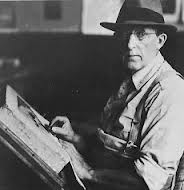Bolton Coit Brown (Bolton Coit Brown)

Artist, Lithographer, and Mountaineer. He is remembered as one of the founders of the Byrdcliffe Colony in Woodstock, NY, part of what is now referred to as the Woodstock Art Colony. He attended Syracuse University, Syracuse, New York, where he received his Masters Degree in Painting. In 1891 he moved to Stanford, California to create the Art Department at Stanford University and was head of the department for almost ten years, but was dismissed in a dispute over his use of nude models in the classroom. An accomplished outdoorsman and mountain climber, he took advantage of Stanford’s proximity to the Sierra Nevada mountain range, mostly famously explored by Sierra Club founder John Muir. He was the first to record climbing a group of peaks in the Sierras with his most challenging first ascent being Mount Clarence King (also known as Mount King) in August 1896. According to the “Climber’s Guide to the High Sierra,” his ascent of Mount King was the first time advanced aid-climbing techniques were used in North America. In 1902 he left California and settled in Windham, New York, where he explored the Catskill Mountains. His skills as an artist and outdoorsman brought him to the attention of Ralph Radcliffe Whitehead, an aristocratic utopian who developed the concept and supplied the funding for the Byrdcliffe Colony. He convinced Whitehead that Woodstock, New York, in the heart of the Catskill Mountains, was where Byrdcliffe should be located. Whitehead authorized him to purchase seven farms totaling more than 1,200 acres and Byrdcliffe was born. Along with novelist and poet Hervey White, also hired by Whitehead, he developed and managed the grounds of Byrdcliffe from 1902 to 1903; however, he and White were both unable to sustain working relationships with Whitehead and he was ultimately fired and White left of his own accord. He went on to create experimental landscape paintings, migrating between Woodstock and New York City, New York, working within the artistic style that came to be known as Tonalism, a landscape form with an overall tone of colored atmosphere or mist. He exhibited one painting at the legendary 1913 Armory Show in New York but, despite skill and dedication, never achieved success as a painter. In 1915 he travelled to England to learn lithography, a printmaking technique, which he soon mastered on his own. He returned to the US in 1916 and occupied the next ten years of his time and intellect with lithography to an almost obsessive degree. He earned his greatest fame printing lithographs for well-known Woodstock artist George Bellows. He created over 400 lithographs of his own, focusing on nature and female nudes. His lithographs “Moonlight Bathers” (1915), “Cloudy Dawn” (1916), and “Sifting Shadows” (1916) are probably his most famous that represent his ability to translate Tonalism from painting into a print medium. He died at the age 71, leaving behind an enormous output of lithographs and writings, including books and articles on painting and lithography and 12 volumes of journals documenting his experiments in printmaking. Prior to his death, he carved his own headstone, a boulder in his yard, and had it transported to the cemetery where he was interred. Mount Bolton Brown in the California Sierras, is named in his honor. (bio by: William Bjornstad) Note: He carved his own headstone, a boulder in his yard, and had it transported to the cemetery.
Born
- November, 27, 1865
- USA
Died
- September, 09, 1936
- USA
Cemetery
- Artists Cemetery
- USA

